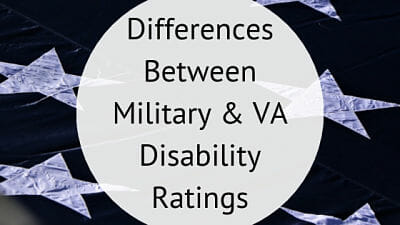Differences Between Military & VA Disability Ratings
Updated: July 11, 2021

The two basic types are Department of Defense (DoD) Disability and VA Disability and those leaving the military soon with potential medical claims should know the details of both.
The Difference Between Military Retirement And Medical Retirement
Before exploring the differences between DoD Disability Pay and the VA equivalent, it’s important to know the difference between ordinary military retirement pay and being medically retired/being given Military Disability Retirement Pay.
When a service member reaches military retirement time-in-service (20 years or more), they can file retirement paperwork, leave the military, and begin drawing retirement pay. Service members do not normally have to retire the second they hit the 20-year mark; some choose to continue serving as long as military regulations will permit.
But the main thing to remember here is that retiring is the servicemember’s initiative and filing the papers means starting the process with an eventual retirement paycheck coming.
Military Disability Retirement is something else; it is not selected by the service member but comes as the result of a medical review process; a military doctor or team of doctors may determine that a veteran’s medical condition warrants disability retirement and this can happen at any stage in the servicemember’s career.
Disability retirement is not automatic even when it is determined that the patient can no longer perform military duties as expected and must be medically separated or retired. Why?
Because if the decision to medically retire or separate someone comes before they have put in the full 20 years of service required to draw retirement pay, the service member could simply be medically separated with severance pay rather than being awarded disability retirement pay.
Remember, this is happening at the DoD level, NOT the Department of Veterans Affairs level. The VA claim process is completely separate from this type of retirement or separation determination.
DoD Disability
When military members are hurt or get sick on duty, the first step in the list of priorities for the Department of Defense is to get the patient treatment and rehab services with the intent of returning the military member to duty as soon as feasible.
During this time, the service member’s physician or care giver team is tasked with determining if the patient is able to return to active duty or if there needs to be further medical assessment under the DoD’s military Disability Evaluation System (DES).
The ultimate goal of DES is to evaluate the patient’s ability to return to duty/fitness for duty. DES is a way to provide a consistent and uniform approach to such evaluations.
DoD Disability Ratings: The Basics
The Defense Finance and Accounting Service (DFAS) official site provides guidelines for service members who need to know how the DoD Disability Rating pay system works. Starting from the time the patient is awarded a disability percentage (determined by the military’s Physical Evaluation Board) a decision will be made as to whether the disability requires retirement or separation from military service.
- Those with less than 20 years of active service who are assigned a permanent disability rating of 30% or more qualify for disability retirement.
- Those assigned a disability rating below 30% are separated, not retired.
- Those with active service totaling 20 years or more will be recommended for retirement “regardless of disability rating”.
There is a very important caveat; for those who had the disability prior to entering military service separation may be recommended without benefits.
According to DFAS, a qualifying patient may be placed on the Temporary Disability Retired List (TDRL) or the Permanent Disability Retired List (PDRL) depending on circumstances. “A member of the TDRL or the PDRL is a retired member of the armed forces. You are entitled to all rights and privileges of a military retiree.”
What You Need To Know About DoD Disability Ratings
As indicated above, there are two general types of disability ratings-permanent and temporary. Each has a set of percentages that may apply to the level of disability. Once you get a DoD disability rating, that percentage will not change over time unlike a VA disability rating which does have the potential for change.
If you get a 30% DoD disability rating and are placed on the DoD Permanent Disability Ratings List, that rating remains for the lifetime of the veteran.
DoD Disability Ratings are determined based on time-in-service, rank, and the disability percentage. This is in contrast to VA disability ratings which are based only on the severity of the medical issue.
DoD ratings apply only to the specific medical issues being evaluated where the VA takes a more holistic approach, considering the entire medical condition of the patient overall. That means that multiple injuries or conditions aren’t necessarily evaluated by the DoD: only the issues directly being evaluated.
What You Need To Know About DoD Temporary Disability
A service member is not automatically placed on the permanent disability list; those who are found to be “unable” or “unfit” to perform military duty thanks to a medical issue that is temporary could find themselves assigned on the DoD Temporary Disability List (TDRL).
In such cases, the DFAS official site states, “While on the TDRL, a physical examination is required at least once every 18 months. If you fail to report for your physical examination, your Branch of Service will remove you from the TDRL list and your retired pay will be suspended until your examination has been completed.”
This kind of retirement pay is calculated as follows:
- The servicemember’s DoD disability percentage (requiring a minimum of 50% for payment purposes while on the TDRL), OR
- Total years of active military service.
In cases where a rated disability “stabilizes” and as a result is awarded a 30% or higher rating, the patient is transferred to the Permanent Disability Retired List (PDRL).
For those with disabilities that stabilize but have ratings lower than 30% and less than 20 years of military service, separation from the military with severance pay will be recommended.
Eligibility For Healthcare, Severance Pay, Other Benefits With A Permanent DoD Disability Rating
Those awarded a permanent disability rating between 30% and 50% by the Department of Defense are eligible for healthcare “with military disability retirement benefits, but may have a lower priority for VA healthcare benefits.” In general a 50% or better rating is required to get the highest priority in the VA healthcare system.
Any disability-related severance pay awarded by the DoD “will be deducted from any later-awarded VA benefits for the same disability” with certain exceptions which include the following:
- The disability occurred in the line of duty in a combat zone
- The disability was the result of a “combat-related event”
Those with less time in service and of lower rank may receive less from the DoD than would be awarded by the VA because of the DoD’s rank-based system. You may also receive a different disability rating from the VA than you would from the Department of Defense.
VA Disability Pensions
The DoD Disability rating system is used before the service member has left active service, and is used in part to determine whether or not the patient should be retired or separated. The VA Disability Rating system and all other associated disability benefits are for after the service member has left the military. The evaluation period may begin prior to retirement or separation, but any compensation would be awarded after leaving the service.
The VA offers benefits based upon service-connected or service-aggravated disability. You may be offered, depending on the nature and severity of the condition(s), VA Disability Compensation or a VA Disability Pension.
Disability compensation is the better-known benefit; if you get a VA-rated disability percentage for a certain medical condition “incurred or aggravated during active military service” you will be awarded compensation based on how the percentage of disability is rated by the VA.
But for low-income veterans who are permanently and totally disabled, OR are at least 65 years old, a Disability Pension may be possible. This type of pension is a need-based benefit and there are income and asset limits. Any such VA Disability pension payments awarded would be reduced based on the income of the veteran, spouse or dependent children residing with the veteran.
Important Differences Between VA Disability and DoD Disability
- DoD disability ratings are for life; VA ratings are subject to change depending on whether the conditions get better or worse within certain VA time frames.
- VA ratings include a review of the patient’s entire medical condition used to inform the rating. DoD disability ratings are only awarded for specific conditions under review.
- VA disability payment may be altered if DoD Disability severance pay was awarded. If you are paid $5 thousand dollars in DoD severance for a disability and the VA awards you disability benefits, those payments will be withheld until the amount of the severance pay has been recouped by the government.
- VA disability benefits are not calculated using time-in-service, time-in-grade, or any such similar factor including rank. By contrast, DoD disability pay is calculated with those factors as an important part of the math.
Receiving DoD Disability Retirement and VA Disability Benefits Concurrently
Under previous legislation and/or government program guidelines, veterans were not permitted to “double dip” by receiving full VA disability benefits and full military retirement pay. However, changes in the law and program guidelines have made the following applicable at the time of this writing:
- Military retirees who have 20 years of active military service and a 100% service-connected rating are entitled to full VA disability benefits and full military retirement.
- Retirees with at least 20 years of service and totally disabled with “individual unemployability” are allowed full VA disability benefits and full military retirement pay.
- Retirees with 20 years of service and a service-connected disability rating between 50-90% are eligible for full VA disability benefits and full military retirement pay.
- Veterans with 20 years of service OR a disability incurred in the line of duty AND a VA disability rating of at least 10% may be eligible to collect both.
 Joe Wallace is a 13-year veteran of the United States Air Force and a former reporter for Air Force Television News.
Joe Wallace is a 13-year veteran of the United States Air Force and a former reporter for Air Force Television News.
Most Popular VA Disability Articles

2024 VA Disability Rates

2024 VA Disability Calculator

2024 VA Disability Pay Dates

How to apply for VA Disability Pay

2024 Cost-of-Living Adjustments (COLA)

2024 VA Pension Rates

2024 DIC Benefits and Rates

VA Disability Back Pay


































































